One of the biggest question marks surrounding the Nashville Predators is who will be the number one goalie heading into the 2020 Stanley Cup Playoffs? However, Pekka Rinne’s resume still trumps Juuse Saros’
Related: 7 Things About Mikael Granlund
Since 2010, Rinne has been the guy, posting a 2.49 goals-against average (GAA) and a .914 save percentage (SV%) across 89 consecutive playoff starts. He has stolen a series in the past. Most memorably, he had a dominant performance in the Predators’ 2017 first-round matchup as the bottom seed against the top-seed Chicago Blackhawks. He, of course, swept the Blackhawks and led the team to their first Stanley Cup Final. He was almost untouchable in that run, with a stellar 1.96 GAA across 22 starts.
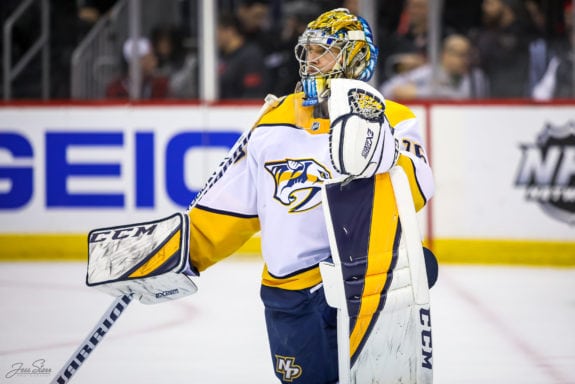
He managed to bounce back from that heartbreaking loss in the 2017 Cup Final. He led the team to a franchise-record 117 points in the 2017-18 season when the team won their first Presidents’ Trophy and he won the Vezina Trophy.
Rinne On the Decline
However, Rinne has been on the decline since. With one year left on his 2two-year, $10 million contract extension, he turned 37 this season and it showed, as the veteran goaltender’s career 2.42 GAA across 14 NHL seasons shot up to 3.17 in 2019-20. Aside from his two-game debut in the 2005-06 season, Rinne’s GAA hadn’t gone over 2.77 until this season. Even his SV % dipped down to a career-low of .895 this season.
These plummets in stats are typical for goaltenders who are nearing the end of their careers. Their bodies get old and have a hard time keeping up with a game that keeps getting faster and faster. Rinne had a respectable start, but the team’s lackluster 19-15-7 performance was pushed onto former bench boss Peter Laviolette who was fired in early January and replaced by John Hynes.
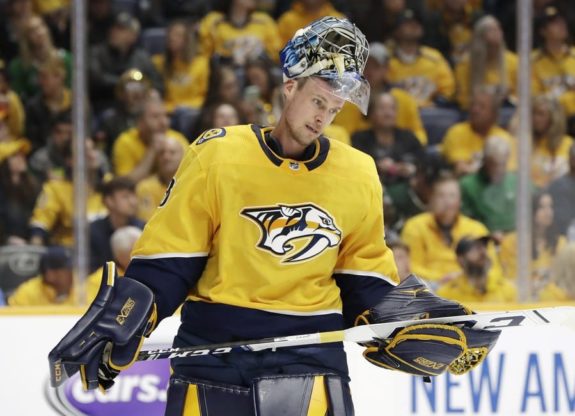
“Time is running out,” said Rinne. “You’ve got to change the way you do things. I think just the bottom line is enough talking. We’ve got to start playing.” He agrees that the team needed a change and acknowledged problems with Laviolette’s coaching after the firing.
Although the team’s overall play changed, Rinne’s struggles continued until the season was cut short. He only made 36 starts in 69 games and ultimately lost the number one spot to up-and-comer Saros.
Saros On the Rise
The team’s play picked up with the addition of Hynes as they finished the regular season with a record of 35-26-8. Hynes made moves that Laviolette wouldn’t have. One of these was giving more playing time to Saros. The 25-year-old netminder was better than Rinne and far more consistent, recording 17 wins and 12 losses. He came up clutch when the team needed him and was able to handle the pressure of being the new go-to goalie in Smashville. Hynes’ savviness led the team to a handful of extra wins that sneaked them into a playoff spot.
Before the regular season was cut short in March, Saros had surpassed his previous career-high of 31 games played in 2018-19, with 40 starts this season. Even though he put up a 2.70 GAA along with a .917 SV% and four shutouts, he still has to prove himself. He has very little playoff experience. In fact, he has never actually started a postseason game.
Saros has only stepped on playoff ice in relief of Rinne, however, he showed the ability to compete in the postseason, even getting some ice time in the 2017 Stanley Cup Final against the Pittsburgh Penguins. In seven career relief appearances, he has managed to hold down the fort with a 1.67 GAA and a .925 SV% in 216 minutes.
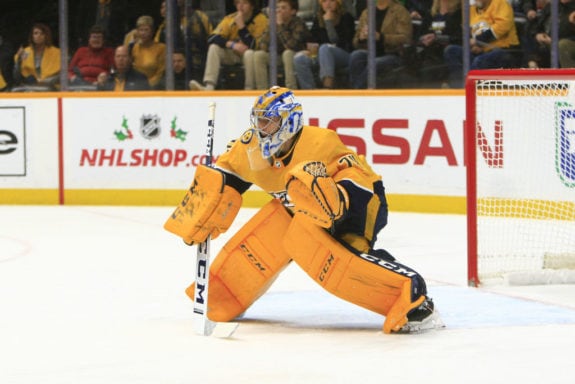
The little playoff experience is only a small sample size of what Saros could be capable, but frankly not quite enough to give him the nod for this season’s playoff run. Remember, Rinne has years of playoff runs under his belt and in this case, experience could be the deciding factor in favour of Rinne. He wasn’t awful this season, but Saros played lights-out prior to the NHL pause. In an interview with ESPN 102.5 The Game, Hynes had this to say about the young goaltender:
I would say this, prior to the pause, Saros was hot. Pekka didn’t play as much, but to be very honest, it wasn’t so much that Pekka wasn’t playing well, it was that Saros was playing so well that it didn’t make … everyone saw it. Pekka saw it, the team saw it, and [Saros] was in such a groove that it only made sense to be able to continue to play him. He was finding ways to win games.
John Hynes
Rinne’s Last Chance
Yes, Saros strung together a number of good starts before the season was paused, but it wasn’t a full season’s worth. If he could have continued his roll, without a doubt he would have started the playoffs, provided the Preds got him there. However, his half-season of success doesn’t quite match up to Rinne’s 14-season resume.
Related: Subban-Weber Trade Revisited
If Saros does get the call in Game 1, stepping out of Rinne’s shadow will be a challenge for him in their play-in series against the Arizona Coyotes. At this point in his career, Saros can handle the pressure, however, Rinne is still highly skilled and his past successes mean that Saros may have to wait for Rinne to falter.
Rinne should get the nod in the qualifiers, if he is well-rested and has had time to fuel up and be ready for what could be his final playoff run with Nashville. No one on the team deserves a Cup more than him. Although he should be on a short leash, Rinne should still be the starter, and if he puts up one bad game, Saros is capable of taking the reins.
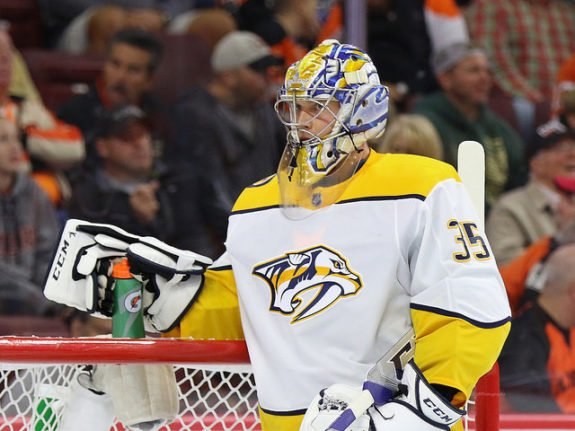
Pekka Rinne, Nashville Predators Oct. 19, 2017 (Amy Irvin / The Hockey Writers) 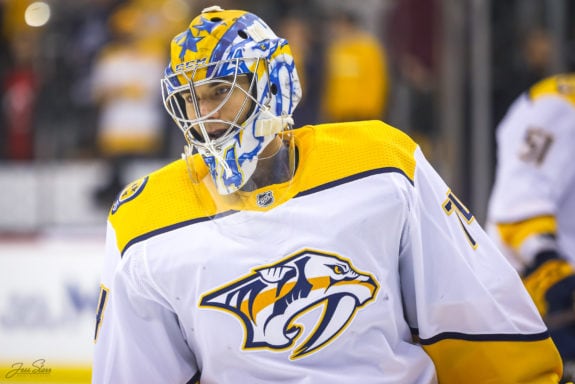
Juuse Saros, Nashville Predators (Jess Starr/The Hockey Writers)
Rinne and Saros have a fantastic relationship on and off the ice. The two Finnish-born players reflect a father-son relationship as we saw in a 2017 episode of Beneath the Ice. Rinne took Saros in as a roommate in the 2016-17 season and took on a father-like role with a young Saros. Saros said that Rinne is like a dad; he cooks and takes pride in Saros’ success. Rinne simply replied, “He’s a good son.” Saros has been groomed for this moment under Rinne’s mentorship, so will be ready when the time comes. That time will just have to wait until Rinne stumbles.